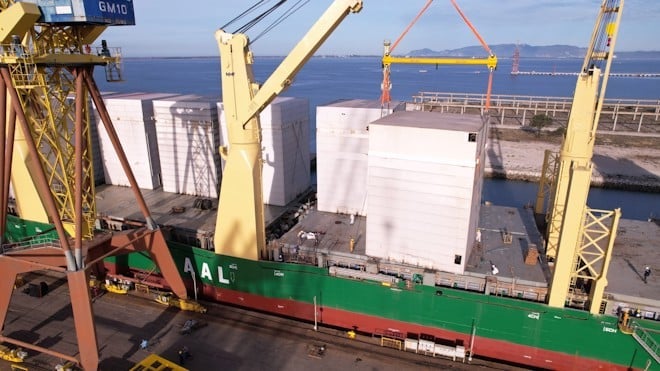AAL Shipping has recently transported eight giant juice tanks safely on a single sailing from Taicang Port in China to Setúbal in Portugal, 50 kilometres south of Lisbon. Carried on its 31,000 deadweight mega-size A-Class heavy lift vessel, AAL Kobe, and along its popular ‘Asia – Europe’ Trade Route, the cargo will be used in a vessel conversion at the Lisnave Shipyard.
The tanks were stowed on deck and extensive operational planning was required to address multiple operational challenges in the lifting and transport of these over-dimensional 150 tonne units, which each measured 12 metres x 12 metres x 16.5 metres and posed visibility restrictions on their journey. They were safely discharged at the Portuguese shipyard, where they will be installed into a bulk carrier, transforming the vessel into a fruit juice tanker.
Yahaya Sanusi, Deputy Head of Transport Engineering at AAL, commented, “We initially had to ensure that a specially designed lifting beam could in fact be aligned, connected, and lifted without mechanical support from the weather deck of the AAL Kobe to the tanks’ trunnions located at 12 metres’ height. Thanks to both the vessel’s outstanding crane height and tailormade lifting beam, we were able to stow the units successfully on deck.

“The goalposts then changed midway through the project, when our initial discharge to quayside plan was replaced by a more ambitious proposal, involving the discharge of the heavy lift units directly to the soon-to-be-converted bulk carrier. After extensive modelling and risk assessment by our engineering team, the original plan was reinstated. We also had to overcome a very shallow vessel draft and other operational restrictions at port of discharge using extensive modelling, bathymetric surveys, and tides, mooring, and risk analyses. This provided the data and operational transparency required for AAL to handle the tanks safely using only the ship cranes. All plans were carefully screened and approved by not only the local port authority, but also insurers and other project stakeholders.”
Christophe Grammare, AAL’s Managing Director, concluded, ‘With almost 95 percent of AAL’s fleet now owned and controlled by us, we can ensure that busy trade lanes – especially those that connect Asia, with key trading markets in Europe, the Americas, and Australasia – are served with the required frequency of sailings all year round. Additionally, we have boosted our engineering and operations capability across all key markets and time zones, and that is well demonstrated on this particular project, when rapidly changing operational criteria and local restrictions needed to be addressed at a local level and smartly.”

Follow us on social media: